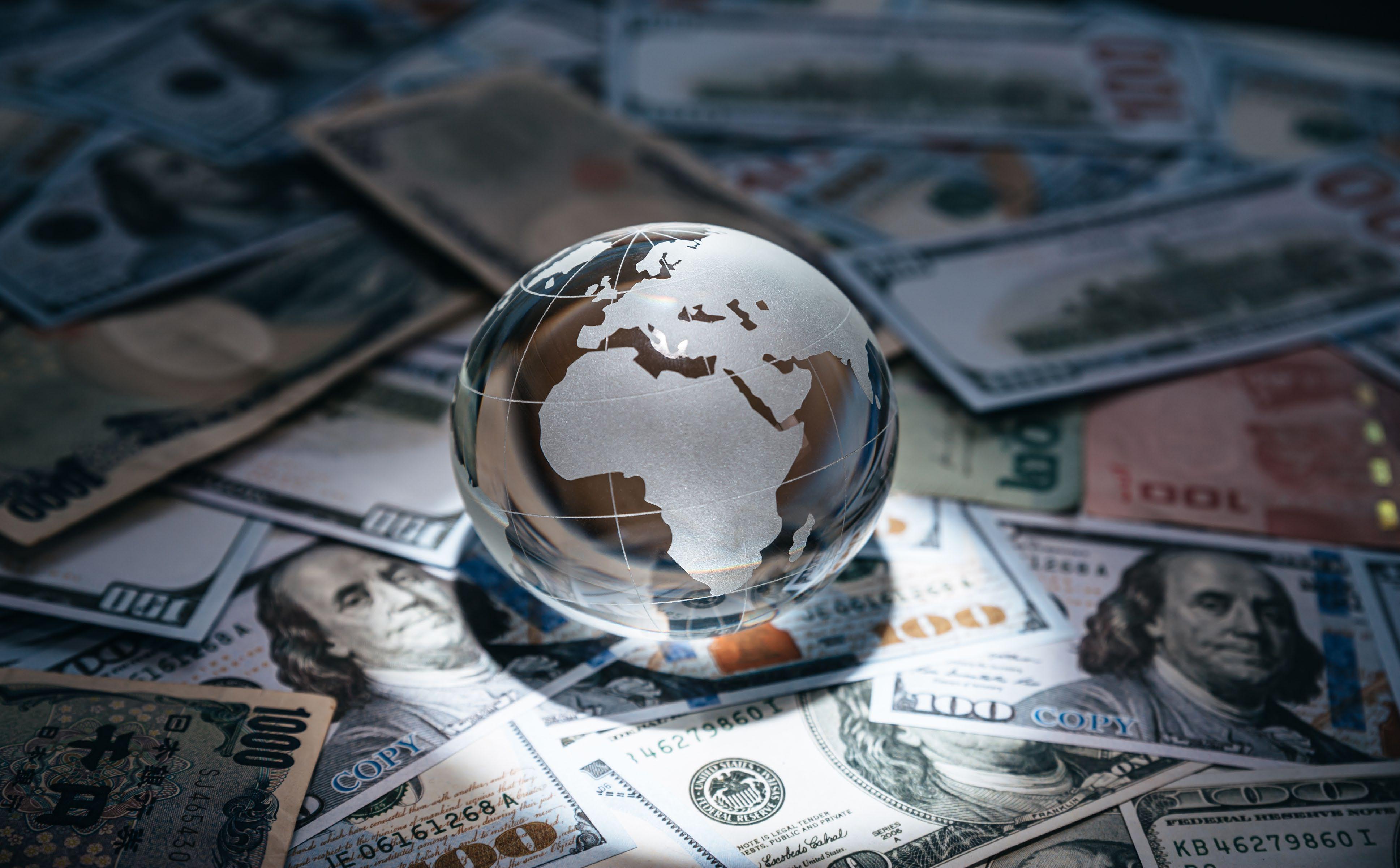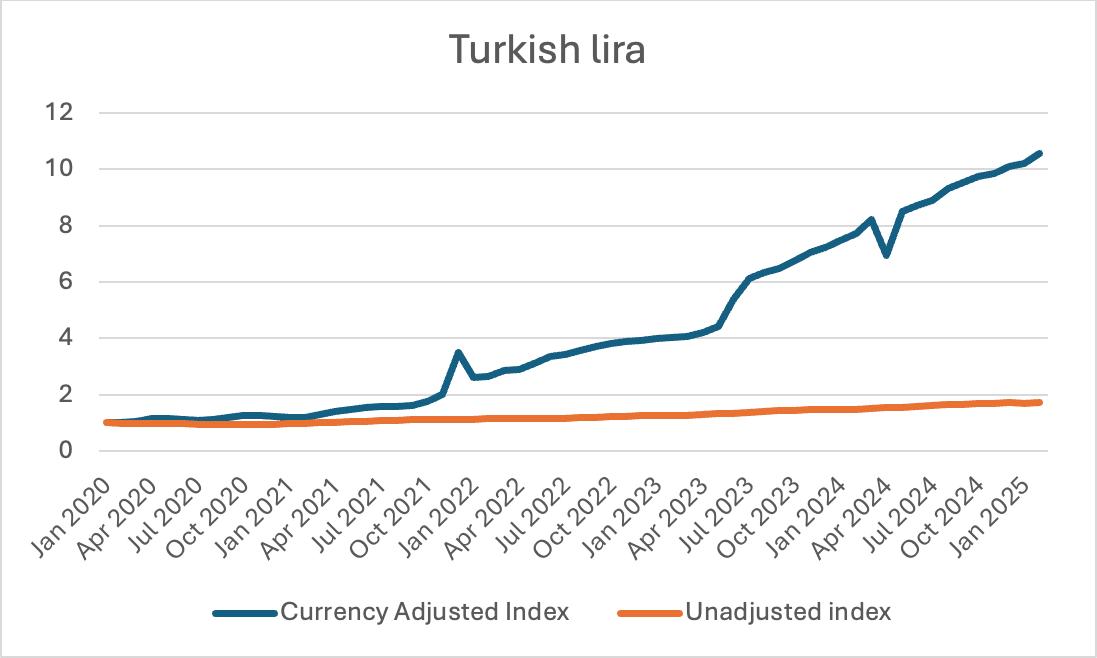




When we introduced currency adusted real estate indices six years ago, we argued that alongside multinational corporates,1 international real estate investors are inadvertent currency speculators, facing currency risk from unhedged investments. We pointed out that they receive two returns: the performance of the real estate itself, and then a gain or loss as a result of changes in the value of the currency in which the real estate performs and that of the overseas investor. Since then the argument that currency volatility can be significant, and the return from the currency can sometimes swamp the performance of the real estate in domestic currency has been amply demonstrated.
Starting from the perspective of the US$, against which Gulf currencies are pegged, the trajectory of other currencies since 2019 has been significant, in some cases dramatic. The US$ has appreciated against all of the currencies of the main investors into Dubai real estate with one important exception. The collapse of the Turkish lira is the most dramatic example:
AED: Turkish lira 2020-2025




The Chinese currency has been much more stable against the US$, but even that has been far from completely level,
AED: Renminbi 2020-2025

Pakistan has followed a similar path to Turkey, if less extreme:
AED: Pakistani rupee, 2020-2025

The Indian rupee has held up better, but still declined:
AED: Indian rupee, 2020-2025

By contrast, in particular to the Turkish lira, the Russian ruble, perhaps surprisingly, has seen relatively little depreciation against the US$ and hence the dirham since 2020. A pure currency investment would have been very successful, however, since 2022, when the Ukraine War began.
The depreciation of the ruble adds 50% to the value of Dubai real estate from a domestic Russian perspective.
AED: Ruble 2020-2025

Sterling has been on a roller-coaster trajectory over the past five years, with no recent benefits for UK investors, but there has been no significant decline as in the other jurisdictions that lead the table of investors in Dubai real estate. It might be tempting to conclude that Brexit has brought the UK nearer to US economic management, so that at least from a currency perspective, domestic investment is more attractive than it was in the past. Parallel debt trajectories also militate against any sudden reversal in the fortunes of sterling
AED: Sterling 2020-2025

The phenomenal appreciation of bitcoin (and some other cryptocurrencies) has meant that their holders would not have benefitted from transferring to any form of US$ denominated asset since 2020.
AED: Bitcoin 2020-2025

The starting point for our analysis in this case is the history of Dubai residential prices in local currency. Property Monitor has reliable data which is amalgamated in a sophisticated way to provide an accurate picture of the evolution of prices. The chart below tells the story long-term, although our particular interest lies in the shaded area:

By way of methodology, the next steps are to combine the two price histories and then to standardise the results as 2020 January = 1. This produces the following currency-adjusted indices for each currency above.
Turkish investors have been the largest beneficiaries of the decline in their domestic currency. As the chart below shows, their investment in Dubai property at the start of 2020 would have increased by more than six times even without any increase in value in dirhams. That increase has moreover been relatively consistent, with only very small reverses. Although even the most sanguine Turkish investor in Dubai real estate could not expect a similar stellar performance over the next five years, domestic political events in Turkey during early 2025 have not been conducive to a reversal either.

By comparison, for some years, Chinese investors, who have long been aware of foreign exchange risk2, did not see any currency benefit from Dubai investment. On the contrary, in the period before 2020-22, they had to absorb currency losses of around 8%. After the beginning of 2022, however, the position has reversed, and Chinese investors would have made 14% returns overall even if the Dubai market had remained flat.

Pakistani investors have undoubtedly benefitted from the strong dollar. Whereas 1 AED bought just over 42 rupees in early 2020, five years later it bought 76. Inevitably the result of this depreciation of the domestic currency has been that gains from holding Dubai real estate in Pakistani rupees has been dramatic, more than trebling its value over the past five years. No domestic real estate investment can hope to compete with this kind of turbo-charged performance.
Pakistani Rupee

A similar logic applies to Indian investors although to a much less significant extent. In the Indian case it is not impossible to find domestic investments that could compensate for the currency effect of buying in Dubai. But investors would have had to balance the additional domestic risk that such investments would inevitably carry with the downside currency risk of the US$. That so many Indian investors have bought in Dubai demonstrates that they prefer the latter to the former.

The chart below demonstrates the sound logic of those Russians who bought in Dubai when the war commenced.

The main exception to this impressive series of benefits for international investors into Dubai has been the UK. The strength of sterling may go some way to explaining why the UK has lost its crown as the leaders in Dubai real estate investment.
Sterling Index

Beyond the league table of domestic jurisdictions, there are currencies, however, whose investors would not have been well served by exchanging their assets for Dubai real estate. There are no real estate markets denominated in bitcoin, but the extensive capital gains of investors in crypto markets have no doubt seen some decide that on balance they would prefer to reduce their risk and exit into real estate. A longer-term bitcoin currency-adjusted index would tell a very different story, and there is of course no guarantee that cryptocurrencies will continue to appreciate in future as they have done in the recent past. A significant portion of that appreciation, therefore, will have already found its way back into Gulf real estate, and most obviously Dubai residential market. In a very real sense, therefore, the chart below shows two halves of the same coin.


Some further observations are in order. The most obvious is that each of the charts above are presented in an appropriate set of dimensions. By comparison to the benefits accruing to Turkish and to a lesser extent Indian and Pakistani investors, the impact of currency has not been anywhere near as great. It is also important to note that for the analysis above, including for purposes of comparison with property indices, which are available at the most frequent monthly, comparable monthly average exchange rates have been employed. The evidence from the exchange rate charts demonstrates, however, that in some months there can be considerable intra-month fluctuations. The UAE has one of the fastest transaction times for real estate in the world, but even so, values in other currencies and therefore achieved returns can vary depending on when in one of such months settlement actually occurs.
Second, indices in this paper are confined to capital values only for illustrative purposes. In the kind of more detailed analysis that specific investors require, the impact of currency fluctuations on their actual rental income and therefore on total returns are also computed, with the results of exits retrospectively calculated at different points in the data series. In this way advice from Cavendish Maxwell can inform the timing of real estate investment decision-making by overseas investors in dollar-denominated markets.
Third, the significance of currency-adjusted indexes is felt predominantly by four categories of investors. First, those live in a country which is not dollar-denominated and receive income and capital appreciation from their Dubai (or other dollar-denominated country) investments. Second, those who do live in Dubai or any other foreign country, but who remit monies back to their home country.3 Third, those who also live in Dubai, but who plan to return to their own country eventually. Fourth, those who are in the reverse position to the other three, paying a mortgage in dirhams on a property in Dubai, but earning income in their home or a third country. Each of these categories of investor is differently affected by changes in exchange rates, the final category in an opposite fashion to the others.

The effect of exchange rate volatility on investment performance measured in local currency has been even more dramatic over the past five years than over the period we measured when we introduced currency-adjusted real estate indexes. What is remarkable about what has happened since has been the way in which existing members of BRICS such as India and applicant Turkey have seen much larger currency depreciation against the US$ and therefore the dirham than the developing countries such as Iraq and Egypt that we originally cited as examples.4 Currency concerns have been instrumental in propelling Indian, Pakistani, Russian, Turkish and even Chinese investors to the top of the list. In adopting economic policies that have served to reinforce the global dominance of the US$, successive US administrations have done great service to overseas investors in the UAE, Saudi Arabia and other Gulf countries that have currencies pegged to the US$. This has made currency a much more signficant factor in real estate investment decision-making than ever before, and the need to obtain advice and forecasts crucial for overseas investors.



